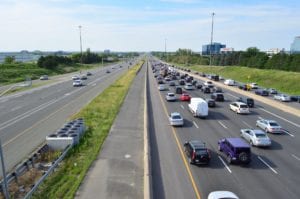Who is a member?
Our members are the local governments of Massachusetts and their elected and appointed leadership.

Gov. Baker’s 10-year transportation bond bill would fund programs and initiatives designed to decrease road congestion across the Commonwealth.
Gov. Charlie Baker filed a 10-year transportation bond bill on July 25 that would authorize $18 billion in capital spending on transportation infrastructure and modernization, but would not increase funding for the Chapter 90 local road and bridge program.
The bill (H. 4002) would fund existing programs as well as several new initiatives designed to decrease road congestion and ensure reliable travel throughout the Commonwealth, according to the governor’s office.
The bill includes substantial funding for projects on the federal highway system, state road projects, state bridge maintenance, rail improvements, regional transit authority programs, and the MBTA system, to name several priorities. The MBTA would get $5.7 billion – $2.7 billion more than the amount already included in the MBTA’s five-year capital budget.
Section 2B of the bill includes capital spending to support municipal transportation projects, including $200 million for Chapter 90 in fiscal 2021, $70 million for the Municipal Small Bridge Program, and $20 million for the Complete Streets Program.
Section 2B would also fund several new programs: $100 million for a Municipal Pavement Partnership Program to help municipalities to maintain locally owned, state-numbered routes; $50 million for a Transit Infrastructure Partnership Program to design and build infrastructure to improve operation of MBTA and other regional transit buses; and $50 million for a Local Bottleneck Reduction Program.
In a letter to the governor and the transportation secretary in advance of the release of the bond bill, the MMA repeated its request for a multiyear Chapter 90 bond authorization of at least $300 million per year, with an annual increase to offset the growth in material and labor costs.
Chapter 90 funding has remained flat at $200 million per year since fiscal 2012 with two exceptions: fiscal 2015, when the governor released $100 million in withheld authorizations and allocated $30 million to a Winter Recovery Program, and last year’s one-time addition of $40 million from the state surplus.
An MMA analysis found that the purchasing power of Chapter 90 funding has dropped by 25.4% over the past eight years, to an inflation-adjusted $149 million in fiscal 2020.
The Massachusetts Department of Transportation’s Capital Investment Plan budget grew by 16.8% between fiscal 2017 and 2019, but the Chapter 90 proportion of that budget decreased from 24.5% to 21%.
“At the very least,” the MMA wrote, “in order to provide stability and guard against the erosive impact of inflation, MassDOT should increase the Chapter 90 allowance to track its own CIP growth. A 16.8% increase in Chapter 90 from fiscal 2017 to 2019 would have lifted Chapter 90 to $233.6 million [in fiscal 2019].”
For most cities and towns, Chapter 90 is the main or sole source of funds for local road construction and repair.